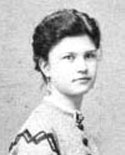Helene Gripenberg was born 12th March 1851 in Oulu. Her mother, Margareta Frosterus, was a housewife and her father, Gustaf Gripenberg, privy councillor. She and her four siblings became orphans as Margareta passed away from tuberculosis when Helene was five years old. Gustaf remarried four years later to Wilhelmina Geschwend. It was common at the time for widowers to remarry soon after their wives’ death, because of the common conception that children need a mother or a motherly figure in their lives. Helene was never close with her stepmother, but she mentions in her memoirs that she had never been close to her mother either since Margareta was rather ill already when Helena was born. The family’s housekeeper Sjöberg, called Pää (Head), was Helene’s mother figure and trusted adult instead.

Helene Bergbom (née Gripenberg, 1851-1932). Picture: SOV.
Two years later after first being taught Russian, German and French by her Russian governess, Helen started her studies in German in Reichberg’s School and later in vicar Streng’s School, also in German. When she was 13 years old she moved to St. Petersburg and started as a free pupil at the Smolna Institute, a boarding school for noble girls. The school had been founded 100 years earlier by empress Catherine II who strived to enhance girls’ education, and Helen was lucky to participate in the centennial celebrations. She writes about the occasion in the memoirs and describes a grand mass in the cathedral of Smolna in which the tsar himself and his family participated.
Att the Smolna Institute the students learned languages (mainly Russian, German and French), as well as Geography, dance, music and etiquette, i.e. all that a young noble lady should know. Parents sent their daughters to Smolna to give them an international, cultural and modern education. In her memoirs Helene writes that the school often took the pupils to visit theaters, operas and ballets. During her time in Smolna she also became a skilled pianist, and encouraged by her uncle she started to perform in public. Music soon became her passion.
The physical and mental health of the girls needed to be good before they were admitted to Smolna, and they took a medical examination before school started. Helene writes that the doctor called her weak, but still let her join the institute. She had to cope with long days, cold classrooms and small rations of food. Everything was in Russian, a language that she in the beginning did not quite comprehend. The other pupils helped her with her homework though and soon she became one of them. The days started and finished with prayer and in between there were six hours of school, an afternoon walk, and some leisure time in the evening.
After she learned Russian properly Helene did well during her three years in Smolna, and when she graduated she received a silver medal for her success. She actually got the highest grades of her class but since she had not done all of her schooling at Smolna and was not of Russian origin, she could not get the gold medal. At 17 she was ready for what she calls “the scary [adult] life” in her memoirs.
Helene Gripenberg returned to her father’s manor outside Viipuri after graduating from the Smolna Institute in 1867. She had no clue what to do next. Her passion, music, was not a proper career according to her family. She tried her luck as a governess, but did not do well. Eventually she got a place as a teacher in Hamina. Later on she studied piano in Dresden for two years with the help of scholarships and mecenatas. After this she worked as a piano teacher for a short time before marrying her second cousin, John Bergbom, who was one year older than her. He owned Hertonäs and Helene became the lady of the manor.
Sources:
Backman, Sigbritt: Hertonäs gård, från säterier till museum, Helsingfors 2016.
Bergbom, Helene: Minnen, Familjeupplaga, 1975.
Morand-Löfving, Elisabeth: Kejserlig uppfostran, finländska flickors skolgång vid Smolna-institutet i S:t Petersburg, Helsingfors 2017.
Translation: EAW
